
Each massage session is tailored to the individual horse’s age, temperament and condition.
Before the horse massage treatment.
If you book a horse massage appointment with Equilibria Gold, after an initial pre-booking chat to ensure there are no contraindications to massage and to obtain the necessary veterinary consent where applicable, I will visit your horse at his/her yard at a mutually convenient time. Initially, I will carry out a static visual inspection looking at the horse’s confirmation as well as any anatomical signs, including muscle atrophy, that may be causing performance problems, tension, or soreness; this will include a hands-on overview to assess for any heat, swelling or abrasions. Following this, a dynamic assessment will be taken watching the horse move in walk, and trot looking for any signs of lameness, imbalance, stiffness, or discomfort. In some cases a tack inspection is valuable.
Horse massage techniques.
Once the initial observations have been carried out the horse massage treatment can begin. This will be tailored to each individual horse depending on what has been identified in the above initial observations, the horse’s age, temperament and condition and then progressively adapted as the massage continues, depending on how the horse responds and any key areas of tension or discomfort that are identified. The duration of a massage session can vary considerably due to these factors.
Take a look below to see some of the key techniques used in horse massage:
-

Stroking.
A gentle rhythmical stroking using the whole palm or dorsal side of the hand. This does not interfere with circulation or lymphatic flow. Benefits of this type of massage treatment are to sooth and relax the horse in both body and mind. Stroking can also be carried out in a stimulating way to stimulate the body’s senses and circulatory systems.
-

Effleurage.
A sweeping motion starting lightly and building as the tissue warms up. Always applied in a centripetal direction (towards the heart) or towards the lymph glands. Benefits of this type of horse massage treatment include warming up the muscles before more penetrative massage work, improving blood and lymphatic flow, speeds up the removal of waste products and supply of oxygen and nutrients to the muscle tissue.
-

Petrissage.
The manipulation of tissues by either picking them up or pressing them down onto the underlying tissues and structures, the benefits of which include better circulation and skin condition, improved muscle and joint health as well as having a direct effect on the nervous system, depending on how the massage is performed.
-

Compression.
A sub-category of petrissage, compression massage techniques also apply pressure to superficial muscles which in turn press against deeper muscles which press against the bone (depending on the area you are working on). Compression massage techniques are useful to relieve congestion within tissues, relax tense or hyper-tone muscles and stimulate the autonomic (involuntary) muscle system.
-

Tapotement.
Used on large muscle groups, this type of horse massage can also be referred to as percussion or pounding. Tapotement is particularly effective at releasing endorphins (the body’s natural pain killers) to enable deeper massage treatment on sore areas.
-

Friction.
Pressure is applied in a transverse direction starting gently and building as required. This type of horse massage can help to reduce adhesions in muscle fibres and reduce scar tissue by stimulating the inflammation and repair process, releasing muscle spasms and increasing blood flow to the area.
-

Jostling.
The rolling technique of jostling or shaking is used to loosen and release the nuchal ligament and trapezius muscle of the neck to relieve tension, help increase the length of the neck muscles and increase circulation.
-

Passive Touch/Sweating.
Sometimes, less is more and the simple act of placing the palm over the area you wish to treat and leaving it until your hand begins to sweat can have a calming effect as well as warm-up muscle fibres for deeper work and relax muscle spasms.
-

Stretches.
Stretching for horses can comprise both active and passive stretching. Carrying out stretch exercises in a controlled manner can highlight imbalances, and stiffness and improve flexibility.
After the horse massage treatment.
Depending on what type of massage your horse had received, the aftercare guidance will differ; for example, a pre-event massage is specifically designed to prepare the horse for exercise, whereas a remedial massage may be working to relieve specific tension and may involve some deep tissue manipulation resulting in soreness for 24-48 hours. As such, I will advise you after the massage session of any particular guidance you need to follow, but as a general rule of thumb for routine/maintenance horse massage here are my top recovery tips:
Urine will usually be darker, have a strong odour and increase in volume due to the stimulation of the lymphatic system, so please ensure your horse is moved following his/her treatment, to a suitable surface to encourage this.
The effects of massage can increase thirst so ensure he/she has access to plenty of fresh water.
Likewise, increased hunger is common so if not being turned out to grass, ensure they have a small haynet available to nibble on.
Massage can cause a reduction in overall body temperature so be observant and, if necessary, perhaps put on extra rugs.
Your horse may be sleepy/drowsy following a relaxing massage so it may be necessary to leave them to rest for an hour before exercising or turning out.
The most obvious, of course, is that your horse may be sore if an area has had to be worked extensively and in this situation rest of between 24-48 hours can be advisable or a change in the type of exercise performed, but I will let you know if this is the case.
Contact us.
hannah@equine-therapy.co.uk
07572 982810
Based in Coalville, Leicestershire.
Offering Equine massage throughout the Midlands.
